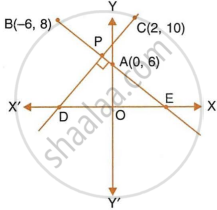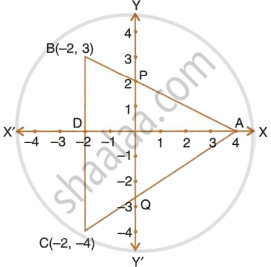Advertisements
Advertisements
प्रश्न
Find the point on the X–axis which is equidistant from A(–3, 4) and B(1, –4).
उत्तर
Let point C be on the X-axis which is equidistant from points A and B.
Point C lies on X-axis.
∴ Its y co-ordinate is 0.
Let C = (x, 0)
C is equidistant from points A and B.
∴ AC = BC
According to distance formula,
`∴ sqrt([x – (– 3)]^2 + (0 – 4)^2] = sqrt((x – 1)^2 + [0 – ( – 4)]^2)`
∴ [x – (– 3)]2 + (0 – 4)2 = (x – 1)2 + [0 – ( – 4)]2 ...(Squaring both the sides)
∴ (x + 3)2 + (– 4)2 = (x – 1)2 + 42
∴ x2 + 6x + 9 + 16 = x2 – 2x + 1 + 16
∴ `cancelx^2 + 6x + 25 = cancelx^2 – 2x + 17`
∴ 6x + 2x = 17 – 25
∴ 8x = – 8
∴ `"x" = (-8)/8`
∴ x = –1
∴ The point on the X-axis, which is equidistant from points A and B, is (–1, 0).
APPEARS IN
संबंधित प्रश्न
Write the equation of the line passing through the pair of points (2, 3) and (4, 7) in the form of y = mx + c.
In ΔABC, A(3, 5), B(7, 8) and C(1, –10). Find the equation of the median through A.
Find the slope and y-intercept of the line:
ax – by = 0
The equation of a line is x – y = 4. Find its slope and y-intercept. Also, find its inclination.
Is the line 3x + 4y + 7 = 0 perpendicular to the line 28x – 21y + 50 = 0?
Find the equation of the perpendicular bisector of the line segment obtained on joining the points (6, −3) and (0, 3).
A = (7, −2) and C = (−1, −6) are the vertices of square ABCD. Find the equations of diagonals AC and BD.
The point P is the foot of perpendicular from A(−5, 7) to the line whose equation is 2x – 3y + 18 = 0. Determine :
- the equation of the line AP.
- the co-ordinates of P.
The points A, B and C are (4, 0), (2, 2) and (0, 6) respectively. Find the equations of AB and BC. If AB cuts the y-axis at P and BC cuts the x-axis at Q, find the co-ordinates of P and Q.
A (5, 4), B (–3,–2) and C (1,–8) are the vertices of a triangle ABC. Find the equation of median AD and line parallel to AB passing through point C.
Verify that points P(–2, 2), Q(2, 2) and R(2, 7) are vertices of a right angled triangle.
Show that points P(2, –2), Q(7, 3), R(11, –1) and S (6, –6) are vertices of a parallelogram.
Prove that :
“If a line parallel to a side of a triangle intersects the remaining sides in two distince points, then the line divides the sides in the same proportion.”
In the given figure, line AB meets y-axis at point A. Line through C(2, 10) and D intersects line AB at right angle at point P. Find:

- equation of line AB.
- equation of line CD.
- co-ordinates of points E and D.
A line through point P(4, 3) meets x-axis at point A and the y-axis at point B. If BP is double of PA, find the equation of AB.
Three vertices of a parallelogram ABCD taken in order are A(3, 6), B(5, 10) and C(3, 2), find:
- the co-ordinates of the fourth vertex D.
- length of diagonal BD.
- equation of side AB of the parallelogram ABCD.
In the figure, given, ABC is a triangle and BC is parallel to the y-axis. AB and AC intersect the y-axis at P and Q respectively.

- Write the co-ordinates of A.
- Find the length of AB and AC.
- Find the radio in which Q divides AC.
- Find the equation of the line AC.
